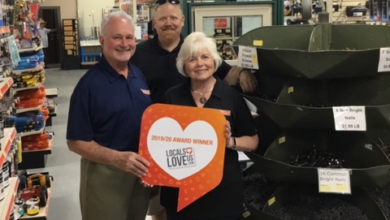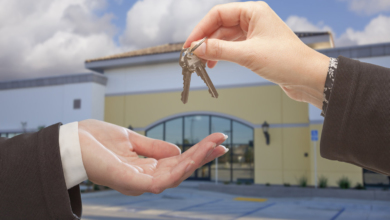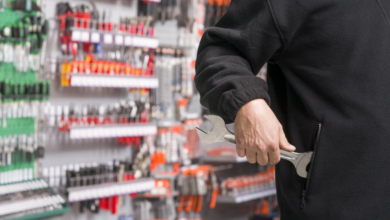Do it Best President Focused on Driving Future Growth + 75 Years of Do it Best History

The history of Do it Best Corp. dates back to 1945, when Arnold Gerberding founded a dealer-owned cooperative then known as Hardware Wholesalers Inc. (HWI). As the co-op marks its 75th anniversary this year, Chris Jensen, editor of The Hardware Connection, conducted an exclusive interview with Dan Starr, president and CEO of Do it Best Corp., about the company’s 75 years of history and future strategic plans.
Jensen: What major initiatives does Do it Best have planned for 2020?
Starr: Do it Best is committed to driving growth as the first and best choice for independent home improvement. In our highly competitive business environment, growth is an absolute imperative and we’re dedicated to fueling growth in ways that drive sales for our members today while positioning us for sustained growth over the long term.
The fuel that drives our growth engine is investment, and our strategic plan has identified key focus areas in the years ahead. One that never changes is our goal of helping our current members grow and achieve their dreams—and our success in doing so touches on a number of other investment initiatives we have in place. Their growth may come from adding new locations, expanding their current footprint or enhancing their execution at retail. We have solutions to help them achieve any of those aspirations. We’re also aggressively working to attract new members into the Do it Best family. Everyone is fighting for market share. But I’m confident in our team’s approach to appeal to independently-minded businesses who want a co-op focused solely on their success.
In reference to our engine for growth, I like to say that we’re fine-tuning that engine while the car is running. There’s no longer time to stop, adjust, test and restart. We’re more agile and responsive when we’re making enhancements while we’re racing forward. So, we’re actively implementing changes and improvements to our supply chain, our IT systems, our marketing programs, and our vendor relationships and product mix. I’m so proud of our team’s ability to tackle all of that and make meaningful progress for our members without skipping a beat.
Our last big investment is in people. And while we are certainly doing things to strengthen our own bench, what I’m talking about is how we’re helping our members attract and retain great employees. Here, training is key and we’ve either created or enhanced a number of our member-focused training programs to benefit store owners and their staff. In an era where others have shifted to online educational options only, we still believe the very best way to invest in people is face-to-face. That’s why our training programs are designed to be multi-day with a manageable class size. This ensures we’re building the participants’ confidence while also helping these employees grow their industry network. So, we’ve invested in our Leadership Development Institute, LBM School, School of Design, Rental School and College of Retail Education.

Jensen: What are the business principles that have remained in place since Do it Best’s founding in 1945?
Starr: There are several key ones that immediately come to mind. First and foremost, it’s that our only goal continues to be to help our independent members grow. It’s been our unwavering focus since Arnold Gerberding envisioned this company, and it’s only grown stronger over the years. In everything we consider doing, we always question whether it will help us drive growth. That has meant we’ve chosen to do some things very differently and we’ve chosen to stop doing other things just because we did them before. These types of choices can be difficult, but they’re necessary for proper focus.
In tandem with our growth mindset is our culture of servant leadership. Going back to our early days, our team was building a servant-led work environment long before that was even a business concept. Today, we look for it when we’re hiring and we screen for it before bringing someone on board. And here’s why: If you’re not fully engaged in serving others, Do it Best is not going to be a good fit for you. Fortunately for us, servant leadership is contagious and our team revels in exceeding our members’ expectations.
Finally, we are diligent in providing a consistently strong rebate to our members. In just the last decade we’ve distributed over $1 billion in working capital for our members to invest in their own growth. Those are dollars that fund store improvement projects and expansions, acquisition of new locations and other powerful growth initiatives.

Jensen: Explain the importance of maintaining financial stability during Do it Best’s history.
Starr: Financial stability is foundational to what Do it Best has been able to accomplish over the years. Stable is the key word here. It isn’t about being conservative or not, and it’s not about debt versus no debt. It’s about focus—being acutely aware of what we want to do and ensuring we’re well-positioned to do it. Stability for us has meant avoiding extreme highs and lows. Our working capital comes from our members. We owe it to them to manage it well. And we do. Because of our financial position, we’ve been ready and able to invest in the right initiatives to continue fueling growth and keep us firmly established as the first and best choice.

Jensen: What leadership lessons have you learned from your predecessors Bob Taylor, Mike McClelland and the late Don Wolf? Does it seem possible that you are only the fifth president in 75 years of company history?
Starr: All of these people have actively lived out a model of servant leadership, each in his own way. With the exception of Mr. Gerberding, I’ve been especially fortunate to have personally witnessed their powerful examples of serving others as they’ve interacted with our members, vendors, staff and even me. And going back to the days of Arnold Gerberding, there are countless stories still shared about these leaders’ singular focus of helping our members be more successful. Both of those are lessons I learned early on and I’m proud to ensure they are even more relevant today.
With Don’s passing last September, I obviously thought a lot about his 70-plus years of influence on our company and on my own development as a leader. Don never stopped learning, never stopped asking questions and never diverted from his core beliefs. He called them his “4 Keys to a Happy and Productive Life” and they informed everything he did and said. As you’d expect, they also have deep ties to our company philosophy, mission and goal. That level of focus and determination to continuous improvement has been deeply influential.

Honestly, when you think about that type of commitment to serving others, it’s not at all surprising that we’ve had such low turnover at the top. Each of us has stepped into that role knowing it’s bigger than any of us and that it takes all of us to be successful. When you can come into work excited to start every day focusing on member growth, it’s something I don’t want to end. It’s why Bob, Mike and Don (before he passed) regularly reached out to me and remain some of our strongest ambassadors today.

Jensen: For Do it Best to continue prospering for the next 75 years, what does it have to do to help members attract the next generation of customers? How do independent hardware and LBM retailers stay relevant in the face of escalating competition from online and big- box companies?
Starr: The key to continued relevance comes down to delivering on the customer experience. In a world where just about anything can be purchased from anyone, how does an independent retailer differentiate themselves in a crowded marketplace? It’s about creating that memorable experience. That experience starts with a store owner’s ability to reach their customers whenever and wherever they’re ready to shop with compelling reasons to buy from them. More and more often, that means using digital marketing with targeted emails and backed up by a website that feels local but has all the functionality and user experiences expected online. Then, it’s about drawing them into the store with an exceptional exterior design and interior layout with aisles that highlight innovative new products and exclusive offerings. Shoppers are met by well-trained, engaged staff who are committed to serve. And everything is supported by a retail system with the agility to respond to new needs quickly, like home delivery and installation, two quickly emerging trends.

The good news for Do it Best members is that the major initiatives we’ve identified for 2020 are addressing all of these elements right now. Remember, we’re fine-tuning the engine while it’s running so members can implement some of these things right now and others are coming later this year. I can’t wait to share more in the months ahead.
Jensen: What are the three biggest decisions or initiatives Do it Best has made that benefited members the most?
Starr: Hands down, I’d have to say our commitment to be the single-source total solution for hardware, lumber and building materials has benefited our members the most. We’re the only ones in the industry who can provide the brand name product selection, mill relationships and reload centers, operational efficiencies, program superiority, experienced sales-driven team and ROI that we deliver every day. It’s how we’re building our strength as a first and best choice provider for today’s independent home improvement business owner.

Taking a page from our history, the launch of the Do it Center in 1981 created a seismic shift in our industry. No one had done it before and with such an impact in the marketplace. We take it a bit for granted today, but professional store design was out of the reach of most independent retailers 40 years ago. For Do it Best members, the best part is that we continue to lead the industry in store design inside and out with the most flexible, scalable and customizable solutions available.

I’ll close by expanding on a point I covered earlier. The fact that we’ve never allowed our future as a members-first co-op to ever be endangered by risky ventures or outside investors has provided a tremendous benefit to our members. Our board of directors is exclusively made up of Do it Best member-owners who understand the needs and aspirations of all our business owners, from hardware stores to lumberyards, commercial/industrial suppliers to e-tailers, as well as international stores in more than 50 other countries. We focus solely on doing what’s best to generate maximum profitability for each of them.



75 Years of Do it Best History
1945: Hardware Wholesalers Inc. (HWI) is founded as a dealer-owned cooperative in Fort Wayne, Ind., by Arnold Gerberding, with nearly 100 independent hardware and LBM retailers banding together to get better pricing from vendors.
1946: First HWI buying market is held in Fort Wayne.
1948: First warehouse facility opens in Fort Wayne.
1955: HWI adds a private truck delivery system with two trucks. It expands and refines its delivery system rapidly, turning it into a major selling point by the end of the decade.
1958: HWI buying markets are moved to the Fort Wayne War Memorial Coliseum.

1964: IBM 1401 computer system is installed to handle data, enabling HWI to expand member services.
1967: HWI has 600 members and $35 million in sales when Arnold Gerberding retires. He is succeeded by Don Wolf, who would transform the company from a regional distributor to a multinational corporation with more than $1 billion in sales.
1971: Cape Girardeau, Mo., is selected as the site for HWI’s first standalone regional warehouse, opening up markets in the South and West.
1974: New distribution center opens in Dixon, Ill., to better serve the Great Lakes Region.
1976: First buying market held in Indianapolis at the Indiana Convention Center.
1977: New distribution center opens in Medina, Ohio, and quickly becomes HWI’s highest-volume DC.
1979: Panama Do it Center becomes the first international member.
1980: New distribution center opens in Waco, Texas, to better serve the Southwest.
1981: HWI introduces the revolutionary Do it Center® design with bright colors and signage.

1986: New distribution center opens in Lexington, S.C. to better serve the South.
1989: HWI reaches $1 billion in annual sales.
1991: New distribution center opens in Woodburn, Ore., to better serve the Northwest.
1992: Mike McClelland succeeds Don Wolf as president and CEO. His focus on serving members leads to strong growth despite the rise of the big boxes.
1995: Do it Best Vision store format is introduced.
1996: HWI establishes an e-commerce website and makes its 61,000 products available on CD-ROM.
1998: HWI merges with Our Own Hardware, a regional co-op in Minnesota. The company name is changed to Do it Best Corp. to better integrate store and product brand programs.
1999: Do it Best reaches $2 billion in annual sales.
1999: New distribution center opens in Montgomery, N.Y., to better serve the Northeast.
2000: After serving on the Do it Best board of directors, Bob Taylor leaves his family’s chain of Do it Best hardware stores in Virginia to join Do it Best Corp. as senior vice president.
2002: Bob Taylor succeeds Mike McClelland as president and CEO. He sharpens the retail focus of Do it Best and navigates the co-op through the recession and housing slump.
2014: New Retail Service Center opens in Sikeston, Mo., after a $34 million investment.
2015: Do it Best introduces an exclusive line of Channellock branded products.
2016: Dan Starr succeeds Bob Taylor as president and CEO.
2016: Do it Best surpasses $3 billion in annual sales.
2017: The Color Bar program is introduced to reimagine the in-store paint experience.
2019: The Do it Best Foundation is created to support community organizations and not-for-profit agencies that serve the needs of others.
2019: Do it Best has 16th straight year of member rebates over $100 million.








